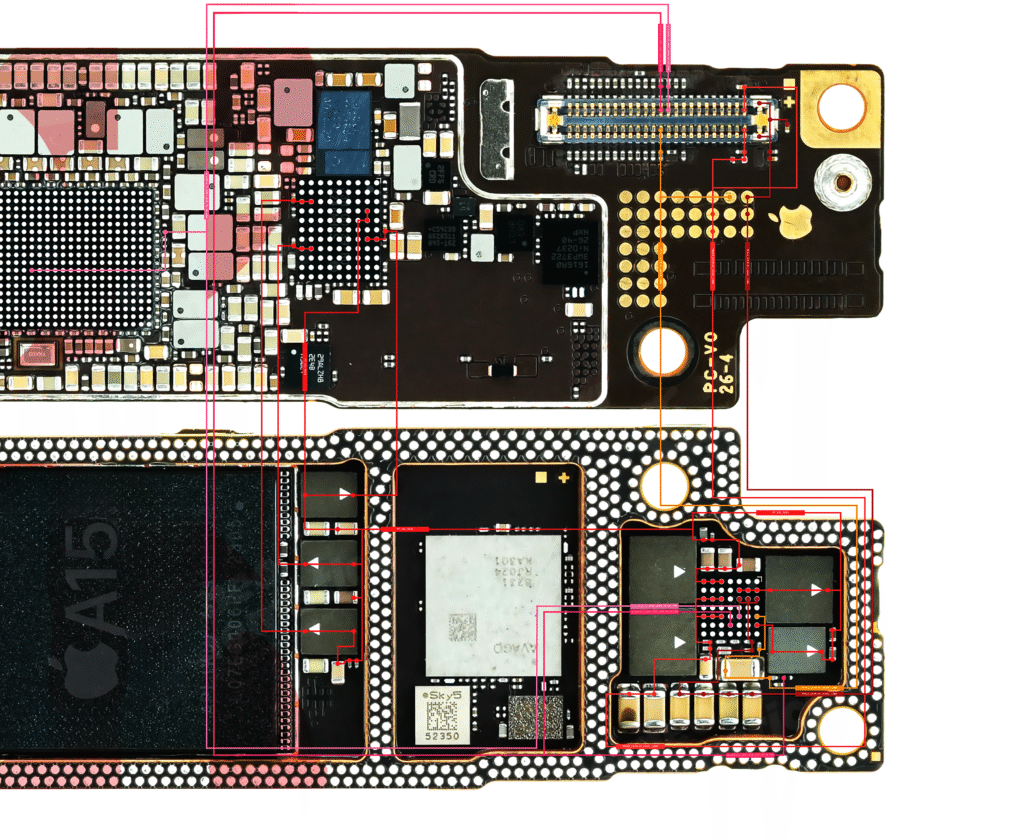Is your iPhone 14 showing a blank or dim display even though the phone is on? This is a classic backlight issue, commonly caused by a faulty backlight circuit, damaged flex cable, or backlight IC failure.
As a mobile repair technician, you need a systematic approach to diagnose and fix this problem. In this guide, we’ll cover:
✔ Common causes of iPhone 14 backlight failure
✔ How to test backlight voltage (with multimeter)
✔ Step-by-step repair method (including board-level solutions)
✔ Using a motherboard image for precise troubleshooting
Table of Contents
🔧 Common Causes of iPhone 14 Backlight Failure
- Backlight IC Failure (Most Common)
- The backlight boost IC (often near the charging port) regulates voltage to the display.
- If damaged, the screen stays dark but may show faint images under bright light.
- Display Flex Cable Damage
- A loose or torn flex cable can interrupt the backlight signal.
- Water or Physical Damage
- Liquid exposure or drops can short-circuit the backlight circuit.
- Software Glitch (Rare)
- A force restart or iOS update might help (but usually, it’s a hardware issue).
📌 Step-by-Step iPhone 14 Backlight Repair Guide
Step 1: Basic Checks (Before Opening the Phone)
- Force Restart (Press Vol Up → Vol Down → Hold Side Button until Apple logo appears).
- Test with another known-good display (to confirm if the issue is screen or motherboard-related).
Step 2: Open the iPhone & Inspect Connections
- Remove screws (Pentalobe P5 near charging port).
- Use a suction cup & pry tool to open the display.
- Disconnect & reconnect display flex cables (check for corrosion or bent pins).
📌 Pro Tip: If the backlight works intermittently, the flex cable may be damaged—replace it.
Step 3: Check Backlight Voltage (Multimeter Test)
If the display connector is fine, the issue is likely on the logic board.
🔹 Refer to the Motherboard Image Below for Pinout:
*(Insert high-quality image of iPhone 14 logic board with backlight circuit marked)*
- Set multimeter to DC voltage (20V range).
- Power on the iPhone and probe the backlight pins (usually labeled PP_LCM_BL_ANODE/CATHODE).
- Normal reading: 15V–20V
- 0V or low voltage? → Backlight IC or circuit fault.
Step 4: Repair or Replace Backlight IC
If voltage is missing:
✔ Check surrounding components (filters, capacitors, diodes).
✔ Reheat or replace the backlight IC (UART or JCV tool may help).
✔ Check diode mode readings on backlight lines (compare with a working board).
⚠ Warning: If you’re not experienced in microsoldering, refer to a specialist.

🔍 Prevention & Final Tips
✅ Always use ESD-safe tools when handling logic boards.
✅ Avoid cheap replacement displays—some may lack proper backlight circuitry.
✅ Check for liquid damage (clean with isopropyl alcohol if corroded).
📢 Need More Help?
If you’re stuck at any step, comment below with your multimeter readings, and we’ll guide you further!
🔹 Save this guide for future reference!
🔹 Share with fellow technicians!
Final Verdict:
Most iPhone 14 backlight issues are hardware-related, requiring flex cable replacement, backlight IC repair, or board-level troubleshooting. Use the motherboard image for precise diagnosis and follow voltage tests before replacing components.
Happy Repairing! 🛠️